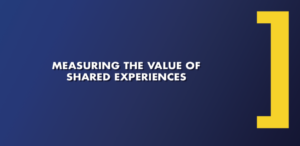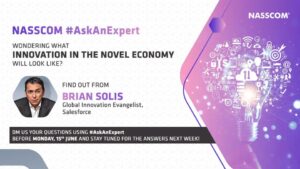
ROI is as popular an acronym in social media as OMG or LOL are in TXTING. No matter how much you believe in social media, the reality is that management needs to know, what’s the ROI of Tweets in “the” Twitter or Likes in “that” Facebook thing that all the kids are talking about? Kidding aside, the future of social media within your organization and the value your customers experience in their networks of relevance is in your hands.
No one said this was going to be easy, and if they did, they didn’t report to the management infrastructure where you and I operate. Change isn’t easy. But, these are the times we read about in books and see in the movies. A classic “Cinderella Story,” if you will. You are the person who will rise against the odds to bring about meaningful change within your organization. Like Cinderella or any other character in an underdog story, you’re destined to take the bumps and bruises before you realize the glory or validation you deserve.
The question remains however, what’s the ROI of social media? It’s a question that is in all reality, unavoidable, but achievable. The pursuit of the answer defines your destiny. Let’s start with a bit of the truth. You cannot measure the ROI of anything when the R, or the return, isn’t defined from the onset of any strategy. Nor can it be measured through the quantification of the 3F’s (friends, fans, and followers) or any other simple math formula tracking Likes, ReTweets, comments, impressions, mentions or sentiment. This is the time to apply a bit more science than history to better understand how to design social media programs that measure a click to action.
Like Me? Why Don’t You Love Me!?
In a classic twist of fate, brands rushed to social networks to seek acceptance in the form of “Likes” and follows. Once there, they found that connection was only the beginning. At the heart of these new communities was just that, a community. And, communities require an investment of not only time and resources, but value…value on both sides. This is about going beyond Likes, this is about loyalty, advocacy, and engagement.
HubSpot’s “The 2011 State of Inbound Marketing” report spotlighted the critical importance of Facebook and Twitter in 2011 business strategies at 44% and 38% respectively. That’s up from 24% and 21% in two short years.

With an increased focus on Facebook specifically, businesses will need a better understanding of what it is consumers want and how it is the company plans on delivering it within an interactive, peer-to-peer environment. eMarketer recently published a report, “Facebook Marketing: Strategies for Turning ‘Likes’ into Loyalty,” to help shed light on the importance of meaningful engagement. The title of the report says it all. Businesses will need to invest less in superficial interactions and more in driving loyalty and steering beneficial customer experiences. Everything begins with defining the value and the experience customers are seeking. Yes, it goes beyond the ask, “Follow us on Twitter and Like us on Facebook.” The reality is however, brands aren’t outright expressing why consumers should do so. Instead the entire premise of many social media campaigns is void of expressed value or meaning and therefore absent of a solid foundation for measurement.
Measurement Starts with Benchmarking Against Progress Toward Business Objectives
In the early stages of social media marketing, brands experimented with measurement by tracking soft, but still necessary metrics such as awareness, engagement, sentiment, mentions, Likes, Followers, RT’s/mentions, comments, etc. Sometimes, these metrics were benchmarked against competitors to demonstrate position and change over time. In an unpublished study that I reviewed, over 50% of businesses admitted not knowing how or what to measure in social media. Without connecting the dots between intention and cause and effect, we are measuring nothing more than activity. However, defining what it is we’re trying to solve for and also identifying desirable outcomes is how we begin to design measurable programs. And, not only do social media engagement programs become measurable, they also by default, start to teach us how performance directly aligns with customer needs, interests and expectations.
In the third annual Benchmark Report: MarketingSherpa, sponsored by Vocus, focused a majority of the insightful 200+ pages on ROI. It begins with a telling sign of the growing importance of social and its ultimate collision with the C-suite. 65% of business’ budgets will increase social spending between 2010 and 2011. Along with that discovery, senior executives are expecting quantifiable results that contribute to ROI or to measurable outcomes.

As mentioned earlier, we cannot measure what it is we do not know to value. Therefore value must be designed into the programs to accurately capture progress and effect.
Moving forward, MarketingSherpa and Vocus found that the priority areas for businesses responding to executive requests to “show them the money” have several issues to overcome.
1. Developing an effective and methodical social marketing strategy
2. Achieving or increasing measurable ROI from social marketing programs
3. Converting social media members, followers, etc. into paying customers
4. Achieving or increasing measurable lead generation from social marketing
The list goes on and on.
The path to measurement starts with a clear picture of the destination and what it takes to get from here to there. Businesses that learn to measure effect and outcomes will discover engagement strategies mature naturally simply because they’re designed to deliver against customer expectations while driving meaningful and measurable experiences. Taking the easy road is tempting, but it’s the path that many are following. Your job is to rise above the fray and connect the dots between social, outcomes, and demonstrable progress toward business objectives. Doing so bridges the gaps that exists between executive management, social media, scale, and customer expectations.
Moving forward, businesses that will leapfrog their peers are those that identify customer needs and business priorities and then reverse engineer them to design informed and measurable programs. Additionally, establishing metrics that benchmark against the opportunity sets the stage for establishing links that connect performance to ROI and ROI to executive support and sponsorship.
Next…
1. Understand the need and the opportunity amongst customers and prospects.
2. Design programs that meet their needs, offer tangible value, and also tie to business objectives.
3. Design outcomes and returns and integrate KPIs that capture progress, performance, and opportunities for optimization.
4. Create a disciplined process that is replicable across the organization and the various social presences that exist or are sure to arise.
Now, show us the way.
Connect with Brian Solis on Twitter, LinkedIn, Facebook
![]()
___
The New ENGAGE!: If you’re looking to FIND answers in social media and not short cuts, consider either the Deluxe or Paperback edition

___
Get The Conversation Prism:

___
Image Credit: Shutterstock





Hi Brian,
I have a different interpretation of this, which may not be popular…
Some ‘gurus’ muddy the waters to make it difficult to determine the ROI.
Why?
Because the actually can’t deliver on their promises. SM works. If you need how to use it.
Not everyone does, thus the kerfuffle re ROI.
Ivan
While it may not be popular, it is indeed true. Thank you for your comment Ivan.
– Brian
___________________
Engage: http://bit.ly/engageme
@briansolis
It seems that executives lately want to have a black and white definition for R.O.I, which is understandable being that there level of responsibility doesn’t allow for long explanations about attracting social media awareness. It is almost as if companies want the wave, but don’t want to create the tide. I believe in trying to gauge R.O.I within a social media campaign, but it should be concerned more with creating a ripple effect to let the program grow organically.
Your business culture becomes what it measures. Focus people on the sales pipeline (selling) and they focus on the process. A customer/client is not represented in a pipeline report (a purposely internally focused document). The business that will succeed maps the Buyer’s Journey sand thinks about how to help prospects / clients to become loyal buyers. As Google is discovering, a purely analytical world-view distorts the intuitive nature of connecting with customers.
You can’t measure what it is you do not value. This measurement of your ROI should be carefully planned and analyzed. Just like how a projectile motion works, if you aim a little too high, you certainly wouldn’t hit your target much the same as when you aim too low. And the thing is, when the goal is reached, it shouldn’t stop there. This is where your statement comes along: This is about going beyond Likes, this is about loyalty, advocacy, and engagement.
Thank you so much for these information and tips Brian! I’ll definitely keep these things in mind. 🙂
“4. Create a disciplined process that is replicable across the organization and the various social presences that exist or are sure to arise.”
I’m really struggling with this in my own efforts, which is why (here in the public record) I’m not selling my knowledge of what *is* working for me. I’m not sure I could replicate it successfully. I’m not even sure I understand what “replication” means in this context (which might be a clue).
The major conundrum, for me, is that I view social media as requiring a modicum of personal attention, which seems contradictory to establishing a disciplined replicable process. Not saying it is contradictory, just that I’m finding it difficult to resolve my perceived contradiction, however real or imagined that might be.
Thanks again, Brian, for another thoughtful piece. I do a bit of blogging once in a while myself; I can appreciate the work you put into these articles.
Datalust. Nice posts and thanks for adding some graphs to my arsenal. Also, when it comes to ROI and measuremnt – man am I glad I have a math degree. Comes in handy these days 😉
In the third annual Benchmark Report: MarketingSherpa and Vocus focused a majority of the insightful 200+ pages on ROI. – Do you think it’s worth purchasing this for the average site owner, I’m certainly ROI focused but it’s not a particularly cheap report. If it gives some good insights though I might splash out on it.
I agree that businesses can innovate to different niches based on social media by coming up with targeted programs and services. It would probably save a business a ton of money as compared to creating something that people don’t want. For businesses that already have established programs and products, they can change their relevance to fit these markets using the data from social media.
I believe that each business should at least run this experiment you’ve suggested doing social media the right way for at least 3-12 months. If even one customer becomes a life long customer, their value for the business is high. To create that overall experience for a customer (and do it right) will most likely result in more lifetime customers.
But, businesses also have to think about the long term effects if they don’t use social media… What percentage of their customers go with their competitor because their competitor informs them about different activities on Twitter while staying at their hotel? or… What customer didn’t see that business’s reaction to the Japan earthquakes and thought they weren’t on top of current events?
Mapping out how and what you measure as your ROI in a social media strategy is definitely important. Most companies miss the mark on this. They want to skip the strategy and go straight into posting without a map. As most of us know, these companies will eventually fall on their rears and come around on the strategy and ROI.
Brian, while all of your points are fantastic and valid, there is one thing that I see you may be missing. What about the value of having a “community of advocates”? While most ROI measures in numbers or conversion rates, you can not measure your community of advocates with the same yard stick. In fact, it is priceless. When you have a community of advocates, you have an “army” of people who will come to your defenses when you or your brand is attacked. Your community of advocates perpetuate your brand unlike any marketing efforts. They are your word on the street, product testers, and writers of reviews. They are the people who will bring you more business than any advertisement.
But how do you measure this new layer of complexity, your social media community? I say you don’t. But, your strategy needs to include efforts to build this community in conjunction with hitting milestones of measurable ROI efforts.
Gwen Woltz,
Wahine Media
@wahinemedia:disqus
wahinemedia.com
Hello Gwen, I don’t disagree with you. There are many facets that require measurement…brand lift, awareness, customer satisfaction, sales, leads, etc., but this is simply a discussion about ROI and why we have to stop dismissing the inability or its unimportance.
Thanks and I appreciate your feedback Brian! I don’t come from a marketing background, so perhaps I tune out all the measuring sticks being slapped around and focus on the ephemeral of social media. I value your opinion greatly though, and I wish I could explain ROI the way that you do. Perhaps I don’t see the difference between measuring ROI and measuring the unmeasurable because to me it’s all a “return”.
My, my, once again I’m in love with how you show up with the data to shore up what you believe. Very impressive.
One trend that Mequoda data shows me reinforces what I believe most businesses not focused on ROI which is fall in love with the New Shiny Object that every one else is participating in at the expense of stuff that brung em to the dance. It seems like before letting the pendulum swing away from tried and true methods of marketing and sales you’d test your way to success.
We’ll see how this all pans out as only time will tell. 🙂
With a clear vision, mission and values, measurement of their presence online will affect reputation. Reputation has a very specific ROI. Good reputation affects share price (or goodwill on the balance sheet of non-quoted organisations); sales margins; ability to motivate, retain and recruit staff and have cost effective vendor relationships. All are measurable. Monitoring the changing value of reputation is a good start. Monitoring the effect of social media’s contribution is evidenced in by the extent to which corporate/product/service values are spread in the conversations.
The contribution of one channel versus another is harder but what we learned from the OBL event is showing us that it is the combination and rate of transfer between media that reflects the transfer of value statements and their uptake.
This means that a (social) media strategy has to be broad based. Facebook is not the answer. It is only one channel.
In the next book (in the typewriter now) I will explore this in greater depth but don’t expect a miracle cure.
Yes, it’s all about knowing why you’re ‘doing social media’ in the first place and having a clear idea of what you want to achieve from it. Waaaay to many people sign up to the idea of social media because they believe they should, without really stopping to think why and how it will benefit the brand and the brand’s advocates. In my experience, social media works fantastically well for gaining feedback on new product ideas and generating buzz about product launches, sales, promotions and offers. With these things, not only does the brand benefit, but the community is also benefiting and getting involved.
Useful piece Brian -thanks for sharing. As with all investments in general and marketing in particular, you need to enter the venture with a clear objective and a strategy for getting there. If it can’t be measured it ain’t wroth doing. I fear lots of people get involved in social media just because they think its the right thing to do.
Jason